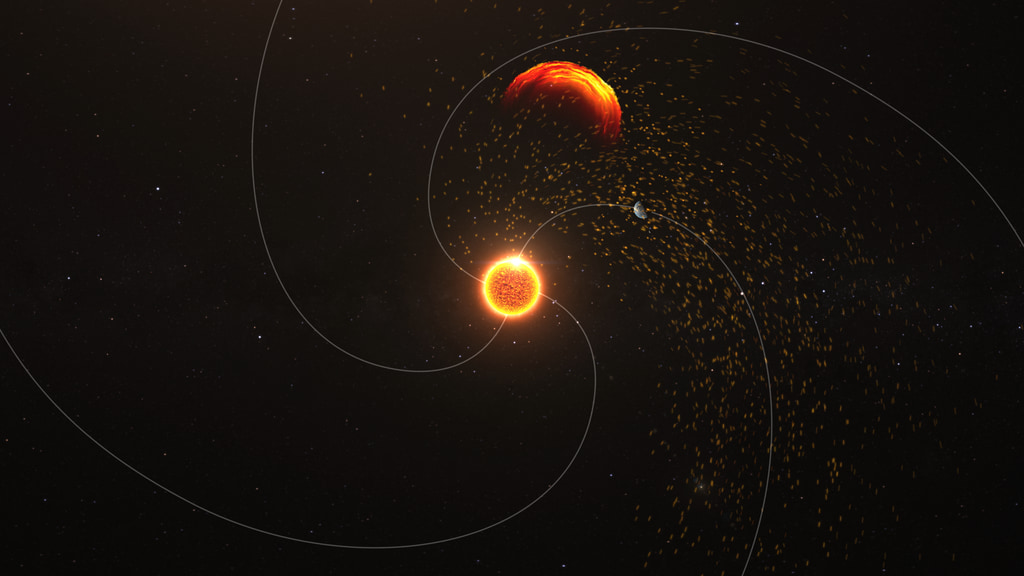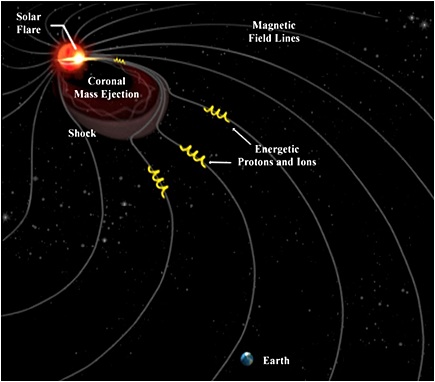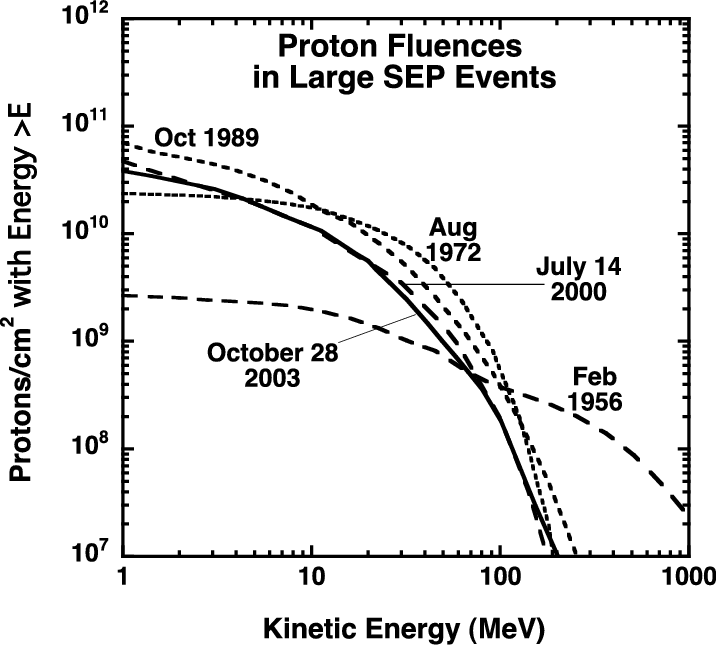
Solar Energetic Particles
Written by: Anwesha Maharana, Mariia Pelekhata, Juska Räsänen, Noemi Zsamberger
What are energetic particles our Sun is regularly shooting out? Solar Energetic Particle (SEP) events originate from solar flares and coronal mass ejections (CMEs) as they accelerate charged particles to high energies. Just as a fighter jet moving at a speed greater than the speed of sound creates a shock wave in air, a CME whose speed exceeds the relevant information speed of the surrounding solar wind drives a shock ahead of it.

Composition of SEPs
The SEP events are composed of a mix of fast-moving particles with energies much higher than the average energy in the corona. They include mostly electrons and protons, but a variety of heavy ions is also present. The composition of each SEP event can be different, and many factors can influence the concentration of ions of a given element in them, such as the time and position of the measurement, as well as the energy and mass of the ions.
The composition of SEP events matters for two fundamental reasons. For researchers, measuring the abundance of various elements and isotopes during these events provides a tool for understanding their origin, as well as their acceleration and transport processes in the heliosphere
For the space industry, knowing the composition helps to protect astronauts and spacecraft. Heavy ions up to iron pose the greatest danger to the equipment aboard the spacecraft, while the radiation hazard to humans in space is mostly related to hydrogen and helium ions. This is partly due to their large numbers, but their danger is also enhanced by their ability to more easily penetrate through shielding.
Detecting SEPs
As SEPs they travel through the heliosphere, we have multiple opportunities to detect them. We can use both space- and ground-based instruments with advanced sensors to measure proton (hydrogen ion), alpha particle (helium ion) and electron fluxes. A well-known example of such instruments is (Geostationary Operational Environmental Satellite (GOES). The cameras of Solar and Heliospheric Observatory (SOHO) often catch a swarm of high-energy particles, too, which appear in their image sequences almost like a flurry of snow.
Lower energy particles are also present in SEP events. We can compare abundances of different energy SEPs in a diagram called an energy spectrum, which shows how many particles were detected for each value of energy within the typical range for SEPs. As we move from lower-, to higher-energy particles,
the energy spectrum shows at first a small, and then a much faster decrease.

Two categories of SEPs
The SEP events can be divided into two categories, impulsive and gradual events. Impulsive events last for a relatively short time (hours) and are generated by solar flares, while gradual events last for a longer time (can last days) and are thought to originate from shock waves driven by CMEs. The two main classes of SEP events show different typical abundances of these main components.
Gradual SEP events are characterised by small ratios of electrons to protons, and they tend to reflect the composition and temperature of the solar corona. These longer-lasting, larger events are also a greater concern when it comes to protecting people and technology from the effects of radiation.
The impulsive SEP events are the flare-related. As opposed to their gradual counterparts, they show a high ratio of electrons to protons, and the majority of them are far richer in heavy elements, such as iron or gold, too.
Challenge to predict SEPs
Having realised the peril of SEPs, the space weather community aims to forecast reliably
6-24 hours prior to arrival of SEPs on Earth.
In addition to arrival time, the intensity of particles in different energy channels and for how long they last, all matter in deciding mitigation steps like shutting down susceptible satellites. The scientific community has developed forecasting infrastructure to issue a forewarning of flares. They apply statistical and Artificial Intelligence models to solar surface observations to predict the eruptivity of flares and to provide a probabilistic intensity of energetic particles. As energetic electrons take tens of minutes to reach Earth upon the onset of a flare, this detection can be used to predict the arrival of energetic protons and heavier ions that cause radiation hazard.
Additional efforts by space weather researchers for earlier warnings include physics-based models that can simulate the propagation of solar wind, embedded CMEs, shocks and the accompanying energetic particles until they reach Earth. This tool helps forecast the arrival of the SEPs and predict their intensity and seriousness of impact, not only at Earth, but other planets as well.
The best methods are still under development and are quite probabilistic to be operational for real-time forecasting. Nevertheless, there is a large motivated community working on finding optimal combinations of observational and numerical modelling approaches to make reliable real-time forecasting a reality.
In summary, SEP events are both interesting and crucial to study as they pose potential risks to the health of astronauts and high altitude flyers, our space and ground-based technological infrastructure, and consequently lead to economic upheaval due to our dependence on technology. There are multiple open questions about SEP origin, their acceleration and modification while they travel through the corona and interplanetary medium due to complex interactions with the solar wind and solar transients like CMEs and shocks. Finding answers to these questions would bring us closer to enhancing our forecasting models towards more reliable predictions and alerts.
